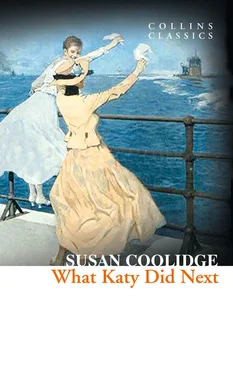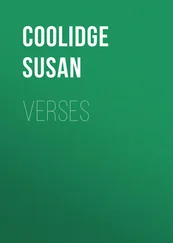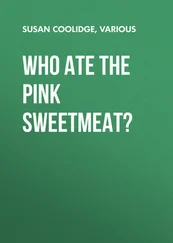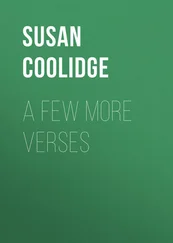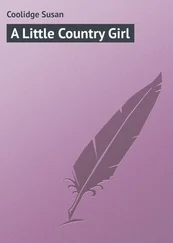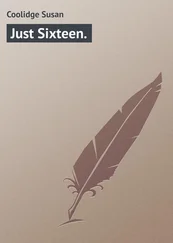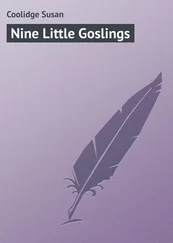WHAT KATY
DID NEXT
Susan Coolidge

This Story is Dedicated
TO
THE MANY LITTLE GIRLS
(SOME OF THEM GROWN TO BE GREAT GIRLS NOW),
Who, during the last twelve years, have begged that something more might be told them about KATY CARR, and what she did after leaving school.
CONTENTS
Title Page WHAT KATY DID NEXT Susan Coolidge
Dedication This Story is Dedicated TO THE MANY LITTLE GIRLS (SOME OF THEM GROWN TO BE GREAT GIRLS NOW), Who, during the last twelve years, have begged that something more might be told them about KATY CARR, and what she did after leaving school.
History of Collins
Life & Times
Chapter 1 An Unexpected Guest
Chapter 2 An Invitation
Chapter 3 Rose and Rosebud
Chapter 4 On the “Spartacus”
Chapter 5 Storybook England
Chapter 6 Across the Channel
Chapter 7 The Pension Suisse
Chapter 8 On the Track of Ulysses
Chapter 9 A Roman Holiday
Chapter 10 Clear Shining After Rain
Chapter 11 Next
Classic Literature: Words and Phrases adapted from the Collins English Dictionary
Copyright
About the Publisher
History of Collins CONTENTS Title Page WHAT KATY DID NEXT Susan Coolidge Dedication This Story is Dedicated TO THE MANY LITTLE GIRLS (SOME OF THEM GROWN TO BE GREAT GIRLS NOW), Who, during the last twelve years, have begged that something more might be told them about KATY CARR, and what she did after leaving school. History of Collins Life & Times Chapter 1 An Unexpected Guest Chapter 2 An Invitation Chapter 3 Rose and Rosebud Chapter 4 On the “Spartacus” Chapter 5 Storybook England Chapter 6 Across the Channel Chapter 7 The Pension Suisse Chapter 8 On the Track of Ulysses Chapter 9 A Roman Holiday Chapter 10 Clear Shining After Rain Chapter 11 Next Classic Literature: Words and Phrases adapted from the Collins English Dictionary Copyright About the Publisher
In 1819, millworker William Collins from Glasgow, Scotland, set up a company for printing and publishing pamphlets, sermons, hymn books and prayer books. That company was Collins and was to mark the birth of HarperCollins Publishers as we know it today. The long tradition of Collins dictionary publishing can be traced back to the first dictionary William published in 1824, Greek and English Lexicon . Indeed, from 1840 onwards, he began to produce illustrated dictionaries and even obtained a licence to print and publish the Bible.
Soon after, William published the first Collins novel, Ready Reckoner , however it was the time of the Long Depression, where harvests were poor, prices were high, potato crops had failed and violence was erupting in Europe. As a result, many factories across the country were forced to close down and William chose to retire in 1846, partly due to the hardships he was facing.
Aged 30, William’s son, William II took over the business. A keen humanitarian with a warm heart and a generous spirit, William II was truly ‘Victorian’ in his outlook. He introduced new, up-to-date steam presses and published affordable editions of Shakespeare’s works and Pilgrim’s Progress , making them available to the masses for the first time. A new demand for educational books meant that success came with the publication of travel books, scientific books, encyclopaedias and dictionaries. This demand to be educated led to the later publication of atlases and Collins also held the monopoly on scripture writing at the time.
In the 1860s Collins began to expand and diversify and the idea of ‘books for the millions’ was developed. Affordable editions of classical literature were published and in 1903 Collins introduced 10 titles in their Collins Handy Illustrated Pocket Novels. These proved so popular that a few years later this had increased to an output of 50 volumes, selling nearly half a million in their year of publication. In the same year, The Everyman’s Library was also instituted, with the idea of publishing an affordable library of the most important classical works, biographies, religious and philosophical treatments, plays, poems, travel and adventure. This series eclipsed all competition at the time and the introduction of paperback books in the 1950s helped to open that market and marked a high point in the industry.
HarperCollins is and has always been a champion of the classics and the current Collins Classics series follows in this tradition – publishing classical literature that is affordable and available to all. Beautifully packaged, highly collectible and intended to be reread and enjoyed at every opportunity.
Life & Times CONTENTS Title Page WHAT KATY DID NEXT Susan Coolidge Dedication This Story is Dedicated TO THE MANY LITTLE GIRLS (SOME OF THEM GROWN TO BE GREAT GIRLS NOW), Who, during the last twelve years, have begged that something more might be told them about KATY CARR, and what she did after leaving school. History of Collins Life & Times Chapter 1 An Unexpected Guest Chapter 2 An Invitation Chapter 3 Rose and Rosebud Chapter 4 On the “Spartacus” Chapter 5 Storybook England Chapter 6 Across the Channel Chapter 7 The Pension Suisse Chapter 8 On the Track of Ulysses Chapter 9 A Roman Holiday Chapter 10 Clear Shining After Rain Chapter 11 Next Classic Literature: Words and Phrases adapted from the Collins English Dictionary Copyright About the Publisher
What Katy Did
The title of this novel is intended as a subtle joke around a play on words. In the US, bush-crickets are known as katydids, because the males elicit a mating call that sounds like the trisyllabic mantra ‘ ka-ty-did ’. On the original front cover of What Katy Did , there was a drawing of five anthropomorphic katydids. The joke is that the katydid insects see and tell ‘what Katy did’ as she goes about her tomboyish mischief in the story. The author imagines they are saying, ‘Katy did this, Katy did that’ as ever-present tattletales, in much the same way that young children are driven to tell the truth about the wrongdoings of their siblings and friends.
The Author and her Female Contemporaries
Susan Coolidge was the oddly modern-sounding pen name of Sarah Chauncey Woolsey, the daughter of wealthy American parents from Cleveland, Ohio. She worked as a nurse during the American Civil War. Woolsey was 30 years old when the war ended and she decided to devote her life to writing children’s books. Curiously, she never had children or married, despite her interest in children’s literature.
Woolsey published What Katy Did in 1872, at the age of 37, and established herself on the literary stage. She continued authoring books until her death in 1905, at the age of 70. Parallels can be drawn between What Katy Did , The Secret Garden (1911), by Francis Hodgson Burnett, and Pollyanna (1913), by Eleanor H. Porter. All three books tackle the subject of paraplegic paralysis in one way or another.
In What Katy Did , the eponymous Katy admires the robustness and goodness of her invalid cousin Helen. She then suffers temporary paralysis herself, due to a fall from a swing, and Helen teaches her how to cope with her affliction until she recovers. In The Secret Garden , there is a reversal, in which Mary teaches her sickly cousin Colin to fight his affliction and learn to walk again. In Pollyanna , the eponymous Pollyanna is paralyzed when struck by a motorcar and finds the will to recover thanks to the love returned to her by the townsfolk.
Читать дальше
